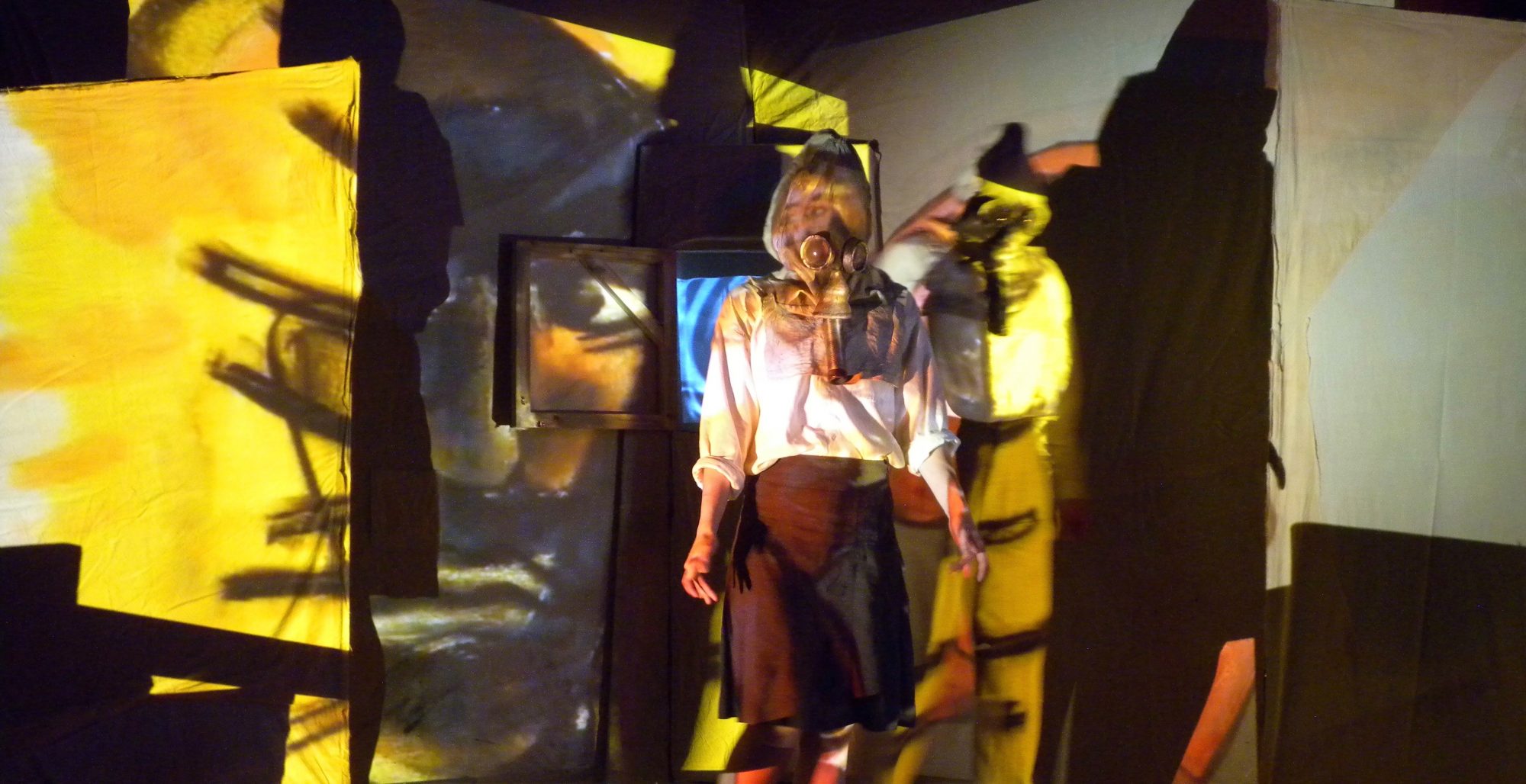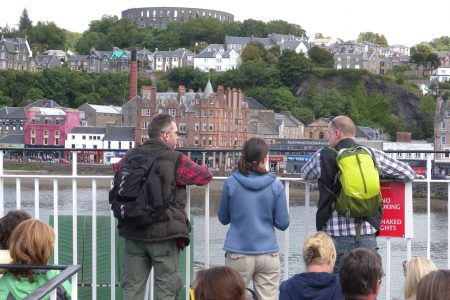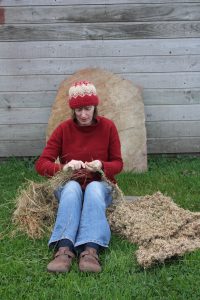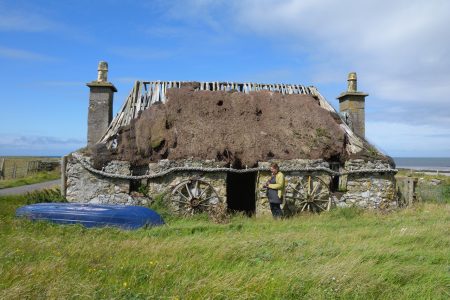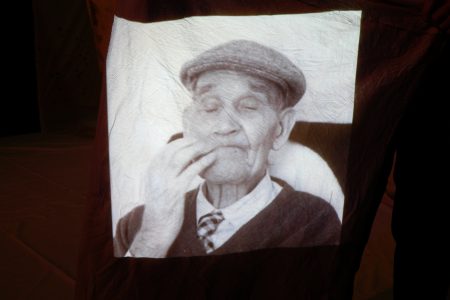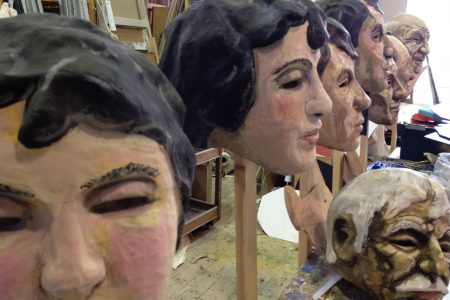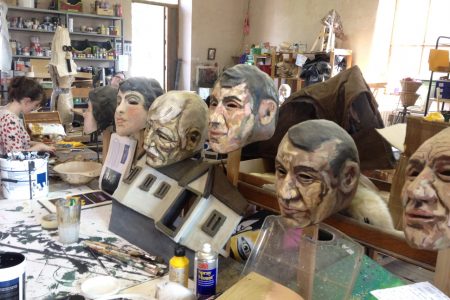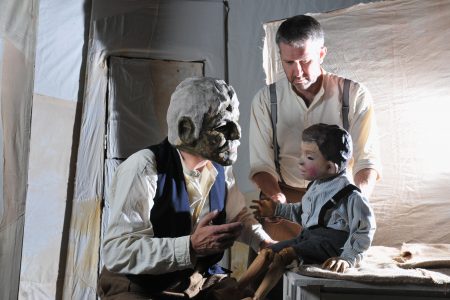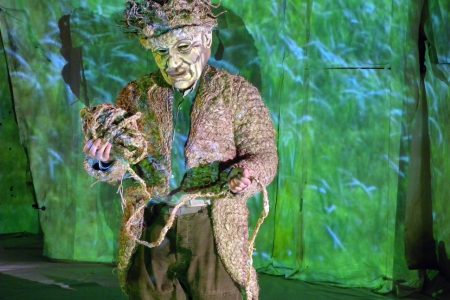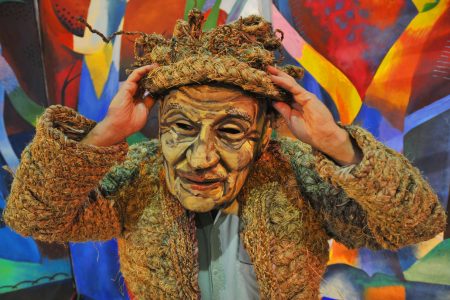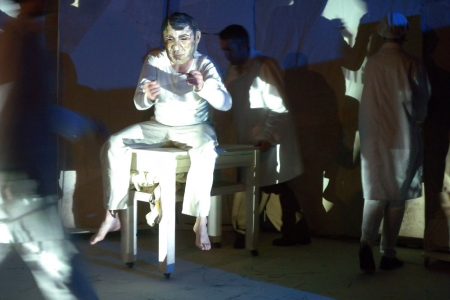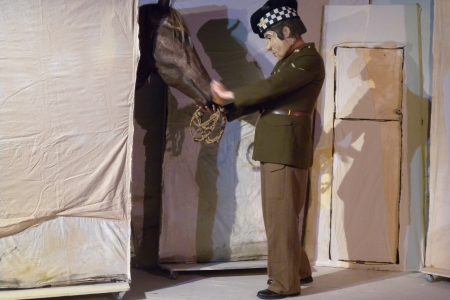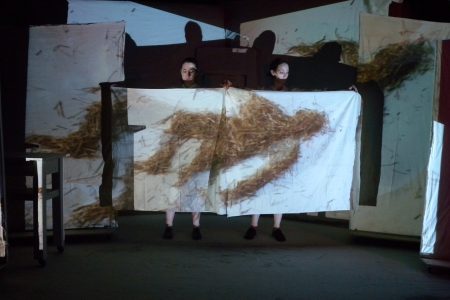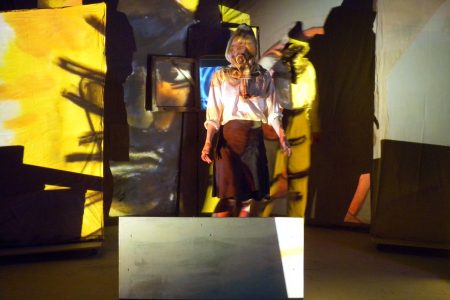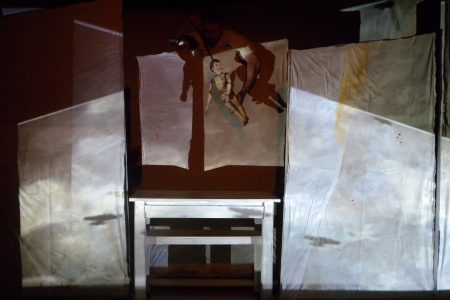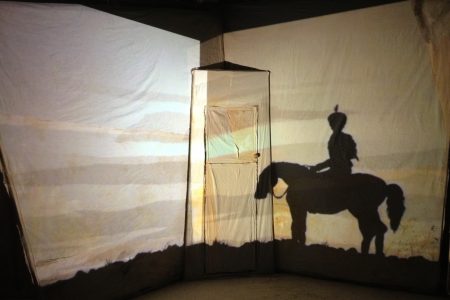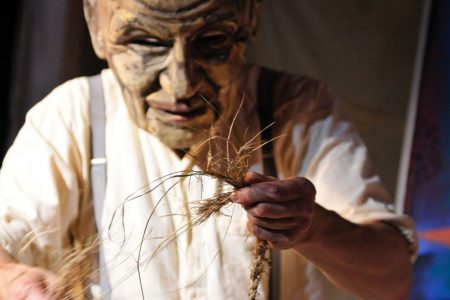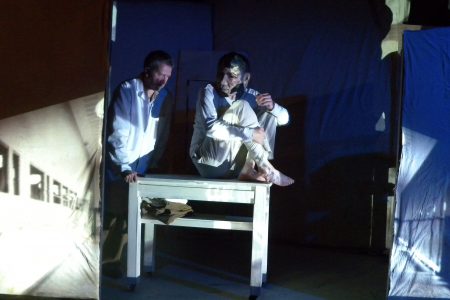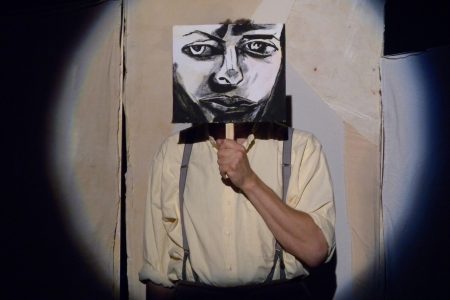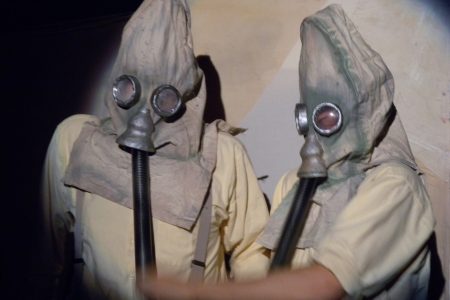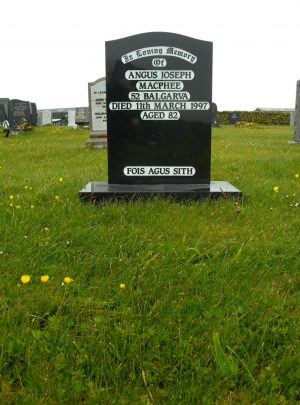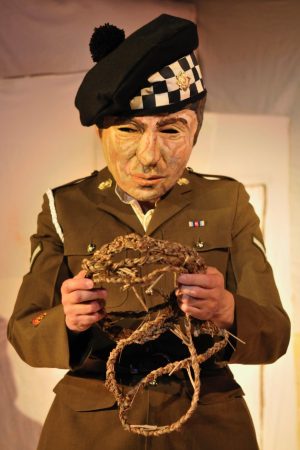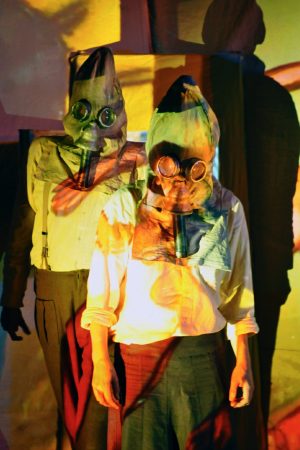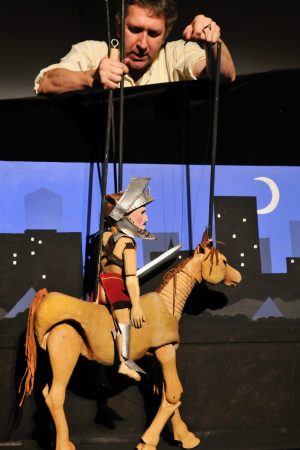By 2011 I hadn’t written and directed a show for two years – since Deep Time Cabaret. This was part of the plan for Alison Duddle to eventually succeed me as Artistic Director at Horse + Bamboo. Nobody however, myself included, had really thought about what my role would be during this period. At the same time the Arts Council shifted its policy 180 degrees. They were now wanted to fund the development of the Boo as a venue and the company as a community arts resource. It looked like the end of our touring work. The work that had been the backbone of the company’s, as well as my own, existence since 1979.
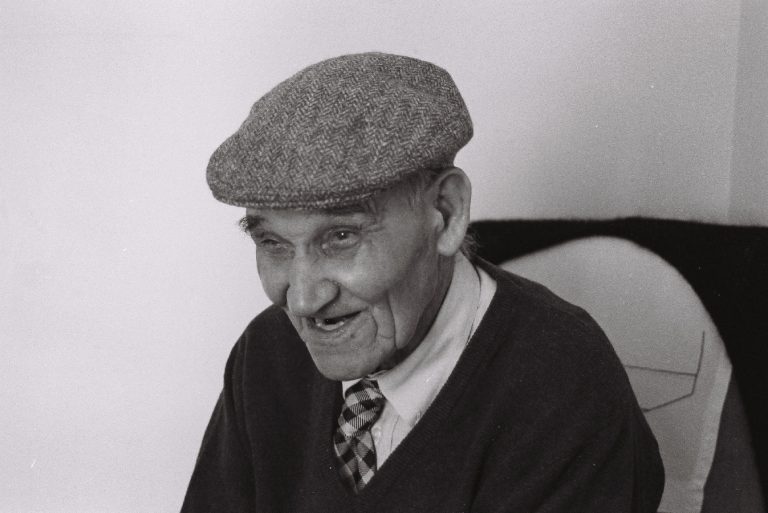
Angus McPhee
The cavalry came in the shape of Creative Scotland, which was now entirely separate from the Arts Council of England. Horse + Bamboo had built a strong following in Scotland, and we had toured there many times. I wanted to tell the story of Angus McPhee (picture above), that I heard from my friend Chris Spears. Chris had first met Horse + Bamboo in North Uist during our tour of the Outer Hebrides in 1984.
Angus McPhee left South Uist in 1914 to fight in the Great War, but he had been invalided out. He then spent half a century in an asylum as an elective mute, choosing not to speak. Instead, Angus wove fanciful clothing from the grasses and other vegetation that he harvested from the hospital farm. Then, in 1994, Angus was suddenly returned to Uist as part of the care in the community scheme. Towards the end of his life he began to receive wider attention as a significant Outsider Artist. Angus died in 1997.
Joyce Laing
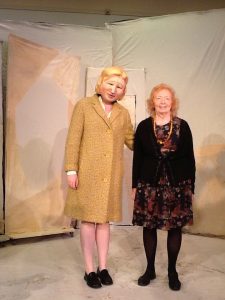
Joyce Laing
Chris wasn’t the only person with a connection to Horse + Bamboo who knew about Angus. Another was Joyce Laing, the Director of Pittenweem Festival. Joyce had been asked to vouch for us during the controversy around the Needles in a Candleflame show in 1983. She had also written the small book about Angus McPhee that Chris had sent to me. In fact it was Joyce who had ‘discovered’ Angus during his long stay in Craig Dunain Psychiatric Hospital in Inverness. She had then publicised his extraordinary work so it became more widely know. Joyce had also visited Angus in his last years back with his family in Eochar on South Uist. She found that he was now talking a little, and was able to interview him.
I went to visit Joyce at her museum and gallery of Art Extraordinary in Pittenweem. This collection held most of Angus’s existent work, and we talked about old times – and about Angus. Eventually I went to the islands to meet with Angus’s family – his grandchildren, nephews and nieces. They were polite and welcoming, but a little suspicious of my plan to write and then tour a play about their grandfather. This wasn’t really surprising, as until recently Angus was hardly known to them. Now, all of a sudden, he had reappeared, transported from a distant psychiatric unit. On top of it all, he had become a sort of artistic celebrity.
Meanwhile, Esther Ferry-Kennington, our Producer, had done a great job in raising interest in the project in Scotland. The interest was both for a new touring show, but also for one that would be partly told in Gaelic. When it became clear that Creative Scotland would offer us financial support for this, the way was clear for me to develop the show.
Joanne B. Kaar
We immediately had a stroke of luck. Searching the internet I came across Joanne B. Kaar. Joanne is a very talented weaver/artist who lives in Dunnet, Caithness, at the very northern tip of Scotland. Further north than John O’Groats. She had already created some pieces of work as a tribute to Angus McPhee, and naturally I made contact with her. The first enquiry ended in her Junk Mail box, and I briefly wondered if she wasn’t interested. But before long I found myself travelling up to pay a visit to her home and workshop. Joanne’s work was extraordinary and inspiring in itself, and Joanne and her husband Joe were extremely welcoming. I spent a couple of days explaining and discussing my ideas for a show about Angus. Once I explained what I wanted she immediately signed up to recreating versions of Angus’s weavings. Before long Joanne joined a group from Horse + Bamboo on a research and development week to Berneray. It was on this trip that I first met Angus’s family.
Uncovering the secret
In fact Joanne’s work on the weavings went far further than I had hoped for. She managed to discover exactly how he had managed to create his woven grass work. Until Joanne’s work on this no-one knew exactly how Angus had made the grass costumes. Joanne’s discoveries and her work for Horse + Bamboo led to her being commissioned first by Joyce Laing, and then by Scottish Museums, to replicate Angus McPhee’s signature pieces. These replica weavings are now in the Scottish national collection. Joyce Laing also commissioned Joanne to recreate Angus’ work for her Art Extraordinary collection.
Gaelic song
Shortly after I went with Loz Kaye to Glasgow to audition Gaelic singers for the production. We saw and heard six singers and instrumentalists. Every one of them was impressive, and it was clear that we were going to have to make a difficult choice. The last audition was with Mairi Morrison, a Lewis born singer and actor who already had an excellent reputation. The idea was to tell Angus’s story in our usual way, using imagery and music, but this time the music would include traditional Gaelic songs. Mairi was the perfect person to help us with this. Not only was she a native Gaelic speaker, but she had a deep knowledge of traditional song. As a result Mairi was able to work with Loz on the whole musical context for the show. As things developed we began to introduce some spoken Gaelic, in addition to the songs.
We were helped massively by Brian Ó hEadhra of the Bòrd na Gàidhlig, Scotland’s national Gaelic language body. Also by Ceòlas, a Uist-based music organisation and An Lanntair, the gallery and arts centre in North Uist. As a result Esther was able to put together a tour of the Outer Hebrides. The show opened at Iochdar, close to where Angus McPhee was born and died. His extended family came to the first show. They remembered my earlier visit and we spoke briefly before the show. Once again they were polite but reserved in a way typical of islanders. Throughout the performance I was extremely nervous, wondering what the family made of it. At the end Angus’s nephew Iain came right over, grinning broadly. He congratulated me and it was clear that the show had met the family’s approval. Other members of the family gathered around, very happy with the outcome. This was the first and biggest hurdle, and we had totally cleared it.
After that the tour went from strength to strength. It was showing to large and appreciative audiences everywhere it went. The publicity it created for the Gaelic language was important too. I wasn’t the only one to notice the irony of it being an English company that had created a successful Gaelic show.
2013 – a second tour
It became clear that Creative Scotland would be happy to support a second tour the following year. As word of the production spread we were also getting interest from English venues. These enquiries were often because the production dealt with issues around mental health.
In 2013 it was noticeable how much things had changed. The name Angus McPhee seemed far better known throughout Scotland. This wasn’t by any means simply the result of our show. A book had been published about Angus by the popular writer Roger Hutchinson. It was entitled The Silent Weaver and was receiving a lot of publicity in Scotland. Roger had generously helped me during the writing of the script, sending me a draft of his book. He then went on to accompany some performances, giving an introduction and sometimes a question and answer session. I also met Donny Munro from Runrig, who had written a song (Weaver of Grass) about Angus some years before. Suddenly it was hard to escape the story of the Silent Weaver! On the North-East coast there was a festival based at several centres and hospitals to look more openly at mental health. The story of Angus – and thus our show – featured prominently in its programming.
Recasting
Mairi sadly had other commitments and couldn’t make a second tour in 2013. I was worried that we wouldn’t find a replacement singer and actor of her standard. Mairi spread the word and promised to help us audition. We finally discovered M.J. Deans! What a find she was! M.J turned out to be the perfect replacement for Mairi. Jordanna O’Neill also replaced Frances Merriman although we retained Jonny Quick and Mark Whitaker. Despite losing Debbie, in the end the second tour turned out to be every bit as successful as the first.
Angus – Weaver of Grass seemed to presage a revival of Gaelic language theatre in Scotland. How much it was part of that change is impossible to know. It was a great show that we were all very proud of. If it contributed in any way to create a climate that made the idea seem like a good one, then it was yet another reason to celebrate it.
If you see one piece of theatre this year, see this. It is a compassionate performance, telling the life story of Angus McPhee, who was born and died on South Uist, but in between suffered the worst that British society could offer to a person with mental health problems. But this is not just a story about suffering, it’s about dignity and the healing power of art. The play, created by Bob Frith and the Horse + Bamboo Theatre, mixes human actors and puppetry in a completely original way. Actors wearing masks interact with puppets, shifting seamlessly from character to puppeteer and back. A clever set, superb lighting and soundtrack, plus use of film and animation, and a combination of Gaelic and English words and songs, make this a many layered and fascinating experience.
It sounds complex, and it is, but it’s far from difficult. The performances are witty and moving and the story is utterly compelling. After a happy rural Hebridean childhood, Angus became a soldier during the Second World War, during which he developed schizophrenia. He was incarcerated for 50 years in Craig Dunain hospital in Inverness, but for most of that time he didn’t require drugs and, in a more enlightened era, would probably not have been in hospital at all. The delusions Angus experienced first as a soldier and then as he became more ill are brought vividly to the stage in a mix of movement, war footage, animation, puppetry, light and sound. The formal treatments meted out by the hospital included electro-convulsive therapy, and the scenes in the play where this is shown are among its most powerful.
Fortunately Angus found his own therapy on the hospital farm, where he wove grass, using techniques he had watched as a child for practical things like halters for horses. He created all sorts of grass objects: hats, bags and even giant boots, gloves, coats and suits, which he would hang on trees or hide under bushes. They were often burnt by hospital staff along with dead leaves, until eventually they were recognised as the artworks they clearly were. The reproductions of these objects, made for the play by Caithness-based textile artist Joanne B Kaar, are quite extraordinary. My only criticism of the play is that the long passage of years as Angus developed his mastery of grass was rather too swiftly played out. I wished that there had been more time spent exploring this craftwork, and the healing that it brought.
Throughout his long hospitalisation, Angus did not speak, and the play reflects this through a minimal use of voice, restricted to songs and a few brief bursts of narration. Mairi Morrison’s singing is superb – unfussy, clear and heartfelt – and the blend of rich Gaelic and a pared-down sufficiency of English is original and very evocative. Altogether, this is the best piece of theatre I have seen in a long time. Catch it if you can. There is an accompanying exhibition about mental health, which adds yet another dimension to this really important and creative enterprise.
“Transporting..a truly moving story…it is an immensely compelling performance…makes very clever use of puppetry, mime and song…weaving a lovely path through this story of a troubled mind. Highly recommended.”
BOB FRITH (wr/dir), JONNY QUICK, MARK WHITAKER, MAIRI MORRISON, LOZ KAYE (m), M.J. DEANS, FRANCES MERRIMAN, JORDANNA O’NEILL also JOANNE B KAAR and VANESSA CARD (making), DANIELLA ORSINI and ELLIE CHANEY (animation), KIRSTY BLACKHALL (m).
